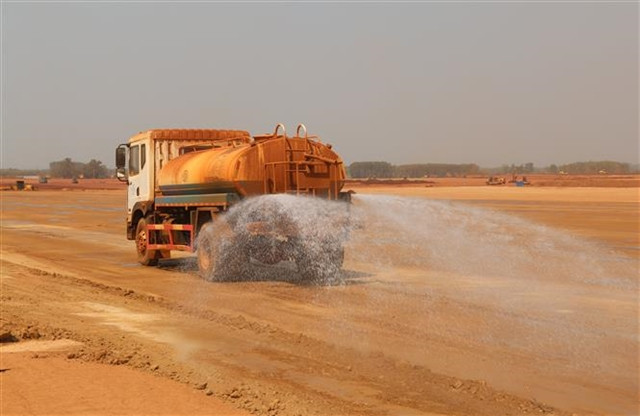 |
| A sprinkler truck in Long Thành construction site. VNA/VNS Photo Công Phong |
The move came after the airport company sent a document to report its plan to reduce dust pollution in the area.
The department said it will coordinate with other agencies to monitor the company’s implementation of dust mitigation measures at the project twice a week.
In the document sent to the environment department, ACV said it will establish a fleet of specialised sprinkler trucks at the construction site with constant frequency.
Construction work will halt when the weather is dry and hot with strong winds.
The area where excess soil is stored that covers more than 720 ha will be covered up and the road surface will be moistened when soil is transported in dry and hot days. Excess soil and rock dumped in the area will be compacted and the company will use vehicles meeting emission standards.
ACV will also provide training for personnel working on the construction site to ensure they comply with environmental regulations.
The vehicles must run on watered service roads, limiting the speed of transport vehicles.
In March 2023, the Ministry of Natural Resources and Environment coordinated with Đồng Nai’s authorities to inspect the observance of the law on environmental protection for ACV at Long Thành airport.
Following that, the ACV was fined VNĐ270 million (US$11,250) for improperly or incompletely implementing regulations mentioned in the environmental impact assessment report.
ACV has neither arranged temporary reservoirs to store rainwater nor built a system of rainwater drainage ditches during the construction process, nor has it built reinforced embankment and sedimentation ponds.
It does not regularly spray water around the construction site, increasing dust in the surrounding environment.
ACV has been punished for causing air pollution with dust levels exceeding five to ten times the standard level.
According to farmers in Bình Sơn Commune, Long Thành District, the red dust from the airport construction site has become pervasive in recent months, spreading heavily to nearby areas of fruit trees and residential areas since February, just as the rambutan and mangosteen trees began to bloom and bear fruit.
The dust has stuck to the leaves, and the hot weather has made it difficult for the trees to photosynthesize, resulting in nutrient deficiency, wilting, fruit dropping, and a failed harvest. — VNS